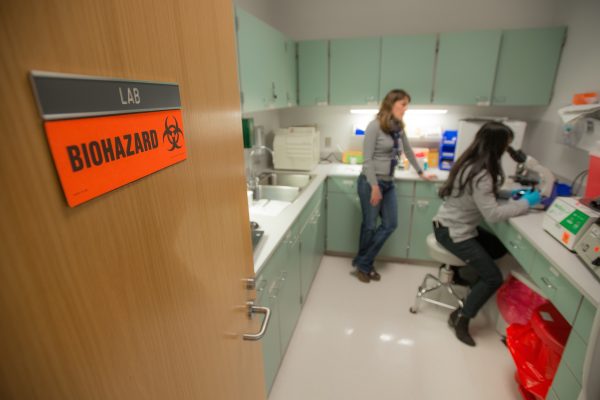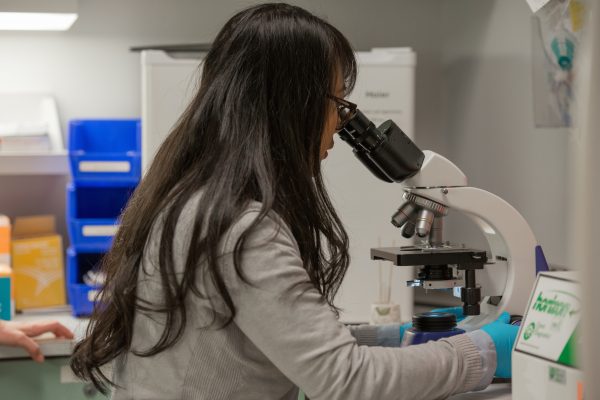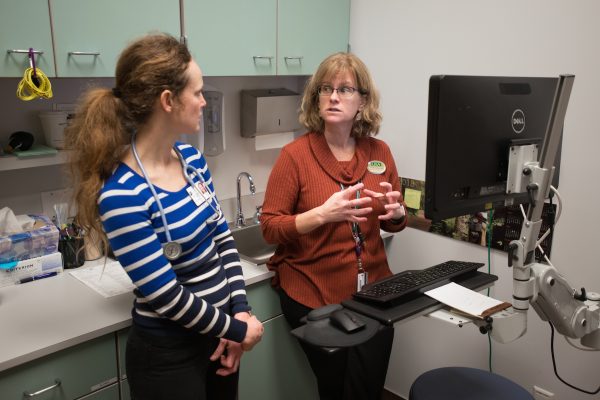Students find care and careers at Health and Counseling Center
by joey |

Nurse Practitioner Theresa Schmitz, left, instructs Mia Camaquin at the Student Health and Counseling Center. Mia is a graduate student intern this semester; Schmitz started at the SHCC as a student intern herself. (Photo by James Evans / University of Alaska Anchorage)
The Student Health and Counseling Center (SHCC), on the ground floor of Rasmuson Hall, has offered low- or no-cost health services for UAA students since 1992. Unlike many clinics, the SHCC provides integrated physical and mental health care, and wraps it all up in the student experience. School is part of the story, whether it's a diagnosis or a treatment plan.
"There's quite a bit of emphasis on the context that a student brings with them ... and it's always within the context of their academic success," said SHCC director Georgia DeKeyser.
The care on campus is not only designed for students, it's often delivered by students too. Each semester, a handful of master's candidates from the College of Health are assigned as interns, paired with a staff member - known as a preceptor in the health field - to complete their degree-required internships.
"There have been well over a hundred students who have had this opportunity," DeKeyser said. She would know. Though she leads the SHCC today, she started as an intern herself while earning her master's in nursing at UAA.
"I know I'm ready"
The preceptor relationship develops quickly. Students from the family nursing and psychiatric nursing programs are matched one-on-one with a staff member, who they observe at the start of the semester (with patient permission). Soon, though, the preceptor pushes the intern to the front.
"I've been working with Theresa Schmitz, who's been a wonderful preceptor and teacher to me," said Mia Camaquin, a master's student who also works as a nurse at Alaska Native Medical Center. "Initially I observed her, then of course she observed me leading appointments, and as soon as she felt comfortable and I showed her I was capable, I started seeing a patient for the entire initial visit," she said.
The program works similarly for students from the psychiatric nurse practitioner program. "It gave me an opportunity to be a provider," said Delphine Atu-Tetuh. "I had my own office, I was on the schedule." That responsibility boosted her confidence. "I learned so much, and [went from] the anxiety of 'I can do this' to 'Yes, I know I'm ready,'" she said.

Mia, a graduate student in the family nurse practitioner program, analyzing slides at the Student Health and Counseling Center. (Photo by James Evans / University of Alaska Anchorage)
"An environment to prosper"
With students as both patients and providers, the SHCC is an all-encompassing educational environment. And since staff members accept student-interns each semester, they've become excellent teachers.
"The entire population we see here are students, and all of them have been really willing to allow [another] student to learn," said Mia.
Even when a student does decline an intern's presence, SHCC staff assigns slides to analyze or medications to administer elsewhere. It's part of the center's team-based learning approach, which provides interns with greater opportunities and patients with better collaborative care.
"Even with the front desks, everyone works so cohesively together," Mia noted.
That team mentality means interns, though matched one-on-one, can ask anyone for support. "There's a lot of teamwork here," Delphine said. "It's an environment to prosper as a student. That really helped me."
"I did family practice. I did everything."
The SHCC placement fulfills the women's health requirement for family nursing practitioner students. The traditional student population aged 18-25 is an important audience to reach with women's health information, but UAA's unique student body also means nearly anyone may walk through the door. Even if a student is 70 years old, they still qualify for low-cost care at SHCC.
"This was my women's health semester but I didn't do only women's health. I did family practice. I did everything," said Mia.
"That's why I like it," added Cori Keene. She previously studied oncology in Tampa, Florida, but decided she wanted a broader medical base. She found that at UAA, in part through her SHCC internship. "You get your women's health but, because we're doing family care, we're getting that too."

SHCC Nurse Practitioner Shellie Flores, right, discusses patient treatment options with Cori Keene, a family nurse practitioner student interning at SHCC this semester. (Photo by James Evans / University of Alaska Anchorage)
"A lot of support"
Students who take advantage of the clinic's free services can expect top-tier care and a sympathetic ear. The staff understands the student experience and takes the time to listen.
"It's all fast-paced [elsewhere]," said Jebb Sagun. At other clinics, he said, patients may see a provider for five to 15 minutes. "Here, they'll take 20 to 40 minutes, which is a lot of time."
That allows him to connect more with his patients. "I feel really lucky to have those stories, to listen to them and what they are here [at UAA] for," he said. "I have a lot of support here with my instructor ... but [the center is] also a really great resource for patients."
Both Jebb and Delphine earned bachelor's degrees from UAA, but all the interns understand the balancing act of college. After all, they're still students too.
"I really struggled in nursing school," Delphine admitted. "When I talk to students, it reminds me of the areas I really struggled with. I just felt I was making a difference to them."
She previously worked in transitional homes for the Department of Corrections and, through her SHCC internships, says she realized the important of mental health for college students, too.
"We have students who are working full time and going to school full time. It can become very overwhelming," she said. "I actually realized how the service was needed in this environment ... When you take care of [mental health], it really improves your grades."
"We feel really lucky"
Several SHCC staff members started as UAA interns and never left - including Schmitz, Mia's preceptor - and this semester's handful of interns can understand why.
Delphine returned for a second internship block this spring. "It was integrating everything that I've studied and putting it together with my experiences," she said. She completed her 240-hour requirement with several weeks to spare. "I learned a lot in a short time."
Family nurse practitioner students complete 180 hours over the semester, and they frequently spend full days in the SHCC, too.
Mia, for one, decided to add more hours. "It was definitely helping solidify all the lectures I was receiving in my classes, so I actually asked my preceptor if I could do more hours, and she was like, 'of course!'" she laughed.
"We feel really lucky that we were assigned here," added Cori. "It has been an excellent rotation."









